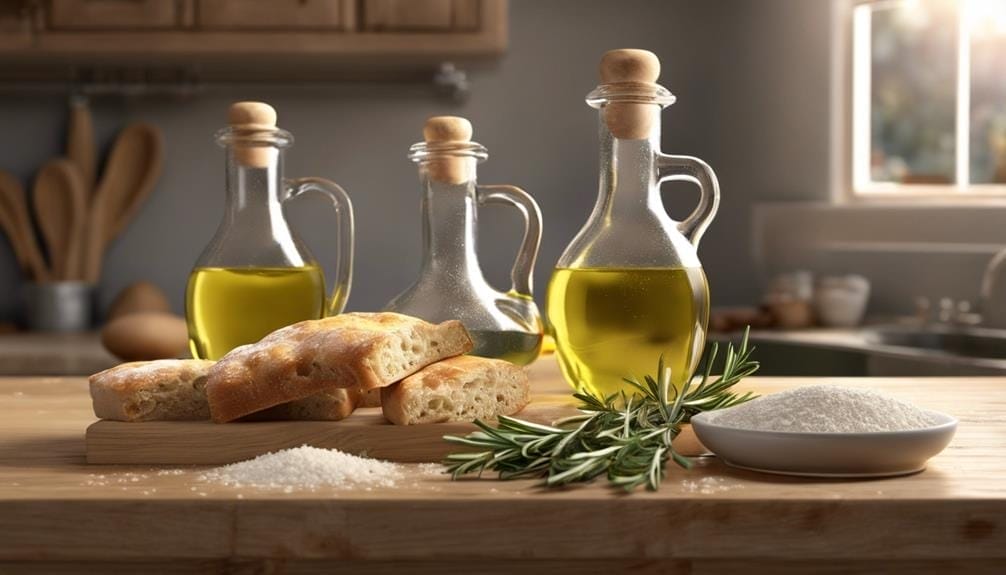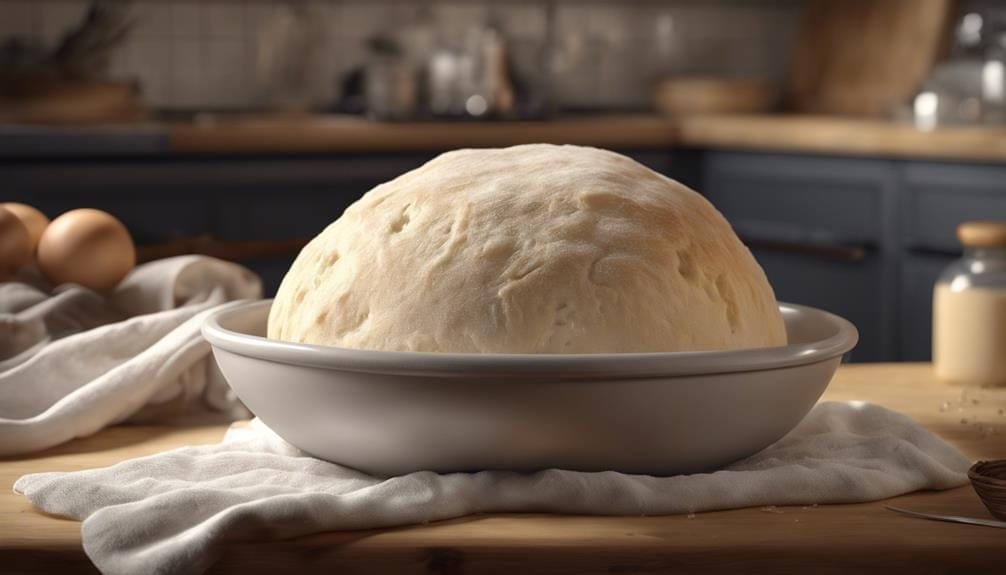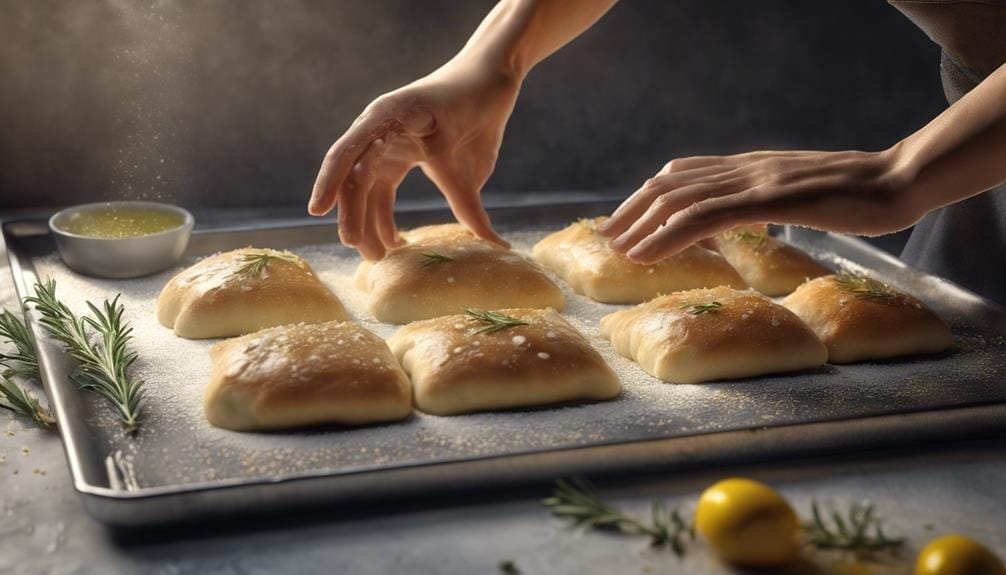To price your homemade fluffy focaccia effectively, calculate the cost per unit by adding up ingredient expenses like flour, yeast, salt, and olive oil. Consider packaging and labeling costs. Factor in your time and expertise to establish an hourly rate. Include overheads like utilities and equipment depreciation. Determine a reasonable profit margin based on market research; aim for a 20-50% markup. Compare prices of similar products in your area to guarantee competitiveness. Monitor costs regularly and adjust prices to evaluate changes. By carefully evaluating expenses and market trends, you can set a fair price that values your effort and appeals to customers.
Ingredients

To make the fluffy focaccia, you'll need specific ingredients to guarantee its light and airy texture. Start with 4 cups of bread flour, ensuring a sturdy base for the dough. Mix in 2 tablespoons of bread flour to boost the fluffiness.
Next, incorporate a quarter teaspoon of active dry yeast, which will help the focaccia rise beautifully, resulting in a fluffy interior. To enrich the flavor, include 2 teaspoons of kosher salt in the mixture. Moreover, the recipe calls for 4 teaspoons of extra-virgin olive oil, contributing to the softness and moisture of the focaccia.
These carefully measured ingredients work harmoniously to create a delicious and fluffy focaccia. Once baked, this fluffy bread can be paired with different toppings like cherry tomatoes, olives, or herbs. It also offers versatile serving options, making it an excellent choice for appetizers, sandwiches, or as a side dish.
Mixing the Dough
To achieve the perfect fluffy focaccia texture, make sure the dough has a high-hydration level and a wet, sticky consistency during mixing. In a large mixing bowl, combine bread flour, kosher salt, active dry yeast, and extra-virgin olive oil according to the recipe. Slowly add water while mixing until the dough comes together. The dough should be tacky but not dry, sticking slightly to your hands. This high-hydration and sticky consistency are crucial for creating the airy and light texture of fluffy focaccia.
Once the dough is mixed, cover the bowl and let it ferment at room temperature for 12 to 14 hours. This long fermentation time allows the flavors to develop and improves the texture of the focaccia.
After fermentation, shape the dough, fold it gently, and transfer it to an oiled pan. Before stretching the dough in the pan, drizzle it generously with olive oil. This olive oil drizzle not only adds flavor but also helps achieve a crispy crust and a soft interior in your fluffy focaccia.
Resting the Dough

Resting the dough for 12 to 14 hours at room temperature is an important step in allowing the flavors to develop and the gluten to form, contributing to the light and airy texture of your fluffy focaccia. During this resting period, the dough undergoes necessary changes. The yeast ferments, creating pockets of air within the dough. These air pockets are what give the focaccia its characteristic fluffy texture.
Additionally, the extended resting period helps in forming a strong gluten network. This gluten network is vital as it provides structure to the dough, allowing it to rise properly and develop that sought-after light and airy crumb.
The flavors in the dough also become more pronounced during this time, enhancing the taste of the focaccia. By resting the dough for the recommended 12 to 14 hours, you aren't only ensuring a fluffy texture but also improving the digestibility and flavor profile of your homemade focaccia.
Shaping the Focaccia
When shaping the focaccia, gently stretch and fold the dough to achieve the desired thickness and texture. Start by shaping the dough into a rectangle or oval shape before transferring it to the pan. Lightly dimple the dough using your fingertips to create those classic focaccia dimples that help with rising. Proper shaping is crucial for even rising and a consistent crumb structure in the final product. Pay attention to the size of the pan and the thickness of the dough to guarantee a fluffy focaccia.
To help you visualize the shaping process better, refer to the table below:
| Shaping Steps | Instructions |
|---|---|
| Stretching | Gently stretch the dough evenly. |
| Folding | Fold the dough over itself gently. |
| Dimpling | Lightly press fingertips to dimple the dough. |
Following these steps will result in a well-shaped focaccia that is ready for the final rising and baking stages.
Baking Instructions

For a perfectly golden-brown and flavorful focaccia, preheat your oven to 450°F and place a pan of water on the bottom rack to create steam. Once your oven is ready, carefully slide the prepared focaccia dough onto a baking sheet lined with parchment paper. Place the tray in the center of the oven and let the magic of baking begin.
Allow the focaccia to bake for 20-25 minutes until it turns a beautiful golden brown color. To make sure it's perfectly cooked inside, insert a thermometer into the bread; it should read between 205-210°F. Once it's ready, take the focaccia out of the oven. Brush the top generously with olive oil, sprinkle some salt or herbs like rosemary for added flavor.
The steam created in the oven will help form a crispy crust on your focaccia, making each bite delightful.
Now, all that's left to do is wait for it to cool a bit before slicing and savoring your homemade fluffy focaccia.
Serving Suggestions
Consider enhancing your fluffy focaccia with a drizzle of balsamic glaze or a sprinkle of freshly grated Parmesan cheese to heighten its flavors. This versatile bread is perfect for pairing with a invigorating salad for a light meal or using it as a diverse sandwich option with your favorite fillings.
The crispy exterior and fluffy interior of the focaccia make it a delightful side dish for a range of meals and a great supplement to gatherings where sharing is encouraged. You can customize your focaccia with different toppings like herbs, cheeses, or vegetables to suit your taste preferences.
For a fresh-out-of-the-oven experience, try reheating your focaccia in the oven before serving. This will help revive its crispy texture and warm up the fluffy bread inside. Whether you're enjoying it on its own or as part of a larger meal, fluffy focaccia is sure to be a crowd-pleaser with its customizable nature and delicious taste.
Storage and Reheating

To maintain the freshness of your fluffy focaccia, store any leftovers in an airtight container at room temperature for up to 3 days. Before storing, wrap the focaccia in plastic wrap or aluminum foil to help retain its moisture and texture.
When it's time to enjoy your focaccia again, reheat it in a preheated oven at 350°F for 5-10 minutes to restore its crispiness. Avoid using the microwave for reheating as it can make the bread soggy.
For longer storage, consider freezing focaccia slices. Place them in airtight containers or freezer bags and store them in the freezer for up to 3 months.
When you're ready to eat the frozen focaccia, thaw it in the refrigerator overnight and then reheat it in the oven to bring back its delicious flavors and textures.
Frequently Asked Questions
Why Is My Focaccia Not Fluffy?
If your focaccia isn't fluffy, consider the rising process, yeast activation, kneading technique, baking temperature, dough hydration, flour type, mixing time, oven humidity, resting period, and ingredient freshness. Each factor impacts the fluffy texture.
Can You Overproof Focaccia Dough?
Yes, you can overproof focaccia dough. Proper proofing balances yeast activity, controls temperature, and maintains dough elasticity. Watch rising consistency, adjust fermentation, and monitor humidity. Overproofing affects dough hydration, baking time, and texture.
What Flour Is Best for Focaccia?
For focaccia, all-purpose flour yields light, airy crumb. Bread flour adds chewiness and structure. Experiment with Tipo 00, whole wheat, or rye for varied textures. Consider high protein for chewier dough. Gluten-free and specialty blends offer diverse options.
Is Focaccia Supposed to Be Crispy?
Focaccia is meant to have a crispy crust and a fluffy texture. Achieve this by using high oven temperatures, dimpling the dough, controlling hydration levels, proofing adequately, and selecting the right toppings for exciting flavor combinations.
Conclusion
Prepare yourself for the fluffy focaccia recipe and savor the delicious flavors of homemade bread.
With simple ingredients and easy-to-follow instructions, this recipe is perfect for any baking skill level.
Whether you're a novice or an experienced baker, this fluffy focaccia will surely impress your family and friends.
So, roll up your sleeves, preheat your oven, and be set to enjoy a warm and fluffy slice of homemade goodness.
Happy baking!